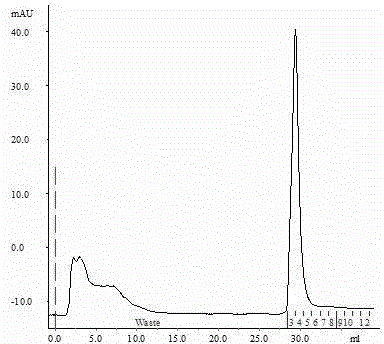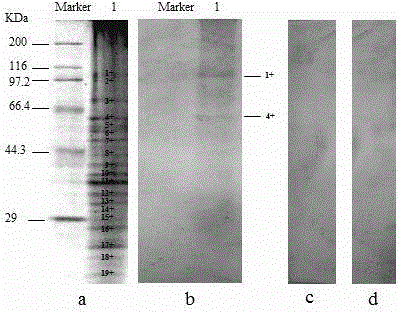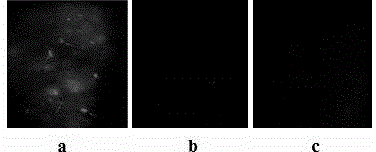Method for efficiently preparing Enterobacter sakazakii polyclonal antibody
A polyclonal antibody, Enterobacter sakazakii technology, applied in the field of immunoassay, can solve the problems of complex preparation process, easy contamination, low titer and purity, etc.
- Summary
- Abstract
- Description
- Claims
- Application Information
AI Technical Summary
Problems solved by technology
Method used
Image
Examples
example 1
[0018] (1) Antigen preparation
[0019] Enterobacter sakazakii ( Enterobacters akazakii ) Streak beef extract peptone (CM0002) solid medium, culture at 37°C for 24h to activate the strain. Wash the bacterial lawn with sterile water and wash it three times, and adjust the bacterial concentration to 1×10 by turbidimetric method. 7 cfu / ml; Formalin was inactivated at 4°C for 24h, spread on the plate and incubated at 37°C for 24h, if there were no viable bacteria, centrifuged at 12000rpm at 4°C for 10min to remove formalin, and the precipitate was obtained by resuspending with an equal volume of sterile water Enterobacter sakazakii particulate antigen.
[0020] (2) Preparation of antiserum
[0021] After one week of adaptive feeding of New Zealand white rabbits, 5-10 mL of blood was collected from the ear vein as negative serum. New Zealand rabbits were immunized with the inactivated Enterobacter sakazakii granular antigen, the specific procedure was as follows: basic immuniz...
example 2
[0028] (1) Antigen preparation
[0029] Enterobacter sakazakii ( Enterobacters akazakii ) Streak beef extract peptone (CM0002) medium, culture at 37°C for 24h to activate the strain. Wash the bacterial lawn with sterile water and wash it three times, and adjust the bacterial concentration to 1×10 by turbidimetric method. 8 cfu / ml; Formalin was inactivated at 4°C for 24h, spread on the plate and incubated at 37°C for 24h, if there were no viable bacteria, centrifuged at 12000rpm at 4°C for 10min to remove formalin, and the precipitate was obtained by resuspending with an equal volume of sterile water Enterobacter sakazakii particulate antigen.
[0030] (2) Preparation of antiserum
[0031] After one week of adaptive feeding of New Zealand white rabbits, 5-10 mL of blood was collected from the ear vein as negative serum. New Zealand rabbits were immunized with the inactivated Enterobacter sakazakii granular antigen, the specific procedure was as follows: basic immunization,...
example 3
[0038] (1) Antigen preparation
[0039] Enterobacter sakazakii ( Enterobacters akazakii ) Streak beef extract peptone (CM0002) medium, culture at 37°C for 24h to activate the strain. Wash the bacterial lawn with sterile water and wash it three times, and adjust the bacterial concentration to 1×10 by turbidimetric method. 9 cfu / ml; Formalin was inactivated at 4°C for 24h, spread on the plate and incubated at 37°C for 24h, if there were no viable bacteria, centrifuged at 12000rpm at 4°C for 10min to remove formalin, and the precipitate was obtained by resuspending with an equal volume of sterile water Enterobacter sakazakii particulate antigen.
[0040] (2) Preparation of antiserum
[0041] After one week of adaptive feeding of New Zealand white rabbits, 5-10 mL of blood was collected from the ear vein as negative serum. Use the inactivated Enterobacter sakazakii granular antigen to immunize New Zealand rabbits, the specific procedure is as follows: basic immunization, 0.7m...
PUM
 Login to View More
Login to View More Abstract
Description
Claims
Application Information
 Login to View More
Login to View More - R&D
- Intellectual Property
- Life Sciences
- Materials
- Tech Scout
- Unparalleled Data Quality
- Higher Quality Content
- 60% Fewer Hallucinations
Browse by: Latest US Patents, China's latest patents, Technical Efficacy Thesaurus, Application Domain, Technology Topic, Popular Technical Reports.
© 2025 PatSnap. All rights reserved.Legal|Privacy policy|Modern Slavery Act Transparency Statement|Sitemap|About US| Contact US: help@patsnap.com



